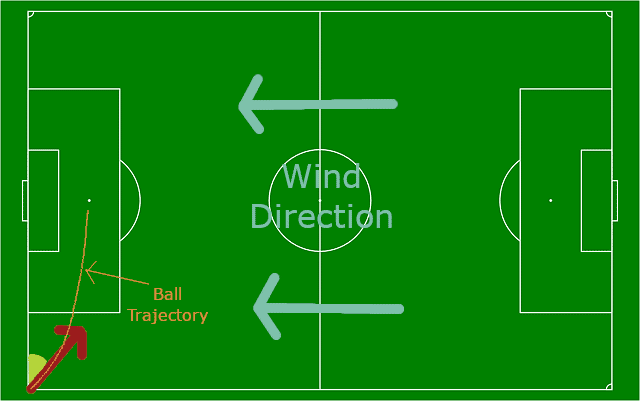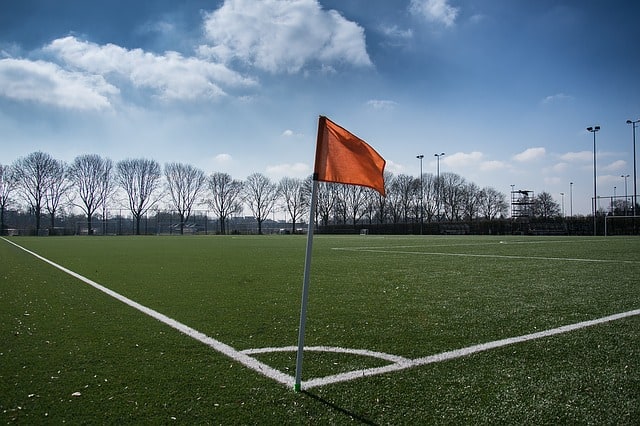When you watch a soccer game for the first time, one thing that you will definitely notice is the corner flags that are placed on each corner of the field.
These corner flags are required by the soccer laws. One corner flag should be placed at each of the 4 corners of a professional soccer field. But, what are these corner flags really used for? And why are they mandatory?
The corner flags that you find on the corners of a professional soccer field are used to help the referees determine whether the ball has crossed the goal line or the sideline on it’s way out of the field. The corner flags are also used to help the players indicate the wind direction while they’re taking a corner kick.
There you have it. These are the main 2 usages of the corner flags in soccer. The rest of this article will be elaborating more on why the corner flags are useful in soccer, and will answer other ‘corner flags’ related questions.
1- Corner flags separates the sidelines from the goal lines in soccer
If you don’t already know, if the ball goes outside of the soccer field during a match, then the game will stop and will need to be restarted. However, the way the restart happens depends on which line the ball crossed before it left the field, and it also depends on which team touched the ball last.
You can learn more about the soccer rules in this beginners article.
But in simple words, if the ball crosses one of the sidelines of the field, a throw-in is given to one of the teams (the team who didn’t touch the ball last). However, if the ball crosses the goal line of the field, then either a goal kick or a corner kick is awarded (depending on who touched the ball last, check the article linked above to learn more about this).
With this in mind, the referee of the match and their assistant referees will have to know whether the ball crossed the sideline or the goal line before it left the field for them to be able to decide what happens next.
Most of the time, it’s super easy to tell which line the ball crossed before it left the field, but sometimes it isn’t as easy as you think it is, especially if the ball left the field exactly at the corner.
This is where a corner flag comes in. If the ball is headed towards one of the corners of the field, then the flag at the corner will force the ball to either cross the sideline or the goal line. In other words, the corner flag will help the referees know exactly which line the ball crossed before it left the field.
2- Corner flags help soccer players tell the direction of the wind
Do not underestimate the power of the wind during a soccer game. Since soccer is an all-seasons game, the soccer players will have to deal with different weather conditions like heavy snow or heavy wind.
However, some soccer players can use the wind to their advantage. For example, a soccer player can use the wind to curve the ball when they are performing a corner kick.
The corner flag will let the player know exactly in which direction the wind is going and it will also give the player an idea of how strong the wind is going. This will help the player that is taking the corner kick decide on how to kick the ball and curve it towards the penalty area of their opponent.
For example, let’s say that a soccer player is taking a corner kick on the left side of the field, and the corner flag is indicating that the wind’s direction is from the right to the left. This means that the direction that the player should kick the ball towards should make a large angle with the goal line, and the wind will curve the ball by itself towards the penalty area of the opponent.

How tall are the corner flags in soccer?
According to Law 1 of the game, the corner flags on the soccer field should be at least 1.5 m (5 ft.) tall.
The main reason why the flags should be at least 5 ft. tall is to make sure that they do not cause any injuries to the players during a soccer game. If the flags were very short, then players might fall on these flags and this can cause them a lot of damage.
Having the corner flags be 5 ft. tall ensures that the players on the field will not fall on the edges of the flag and hurt themselves.
As an extra safety measure, the rules also require that the corner flags do not have pointed-edges or sharp edges.
What happens if the ball hits a corner flag during a soccer match?
The corner flags are considered to be a ‘part of the soccer field’. This means that if the ball hits the corner flag and remains inside the rectangular field, then the ball is still in play and nothing really happens since the flag is part of the rectangular field.
However, it is usually not very common that the ball remains inside the field after it hits the corner flag since the corner flags do not remain standing still when the ball hits them. Instead, they bend (or fall) when the ball hits them with enough power.
Why are the corner flags in soccer flexible or easily breakable?
The main reason behind making the flag so flexible is to make sure that the players do not get hurt if they hit the flag (either intentionally or unintentionally). If the corner flag posts were made up of strong materials, then many soccer players would have hurt themselves when they fell on these flags.
Are the soccer corner flags easily removable?
Yes, corner flags in soccer are very easy to remove and some of them break quickly when they get kicked strongly by a soccer player.
With that said, I will end the article here. Here’s a quick summary of what you have just read.
SUMMARY
The corner flags in soccer exist to help the referees decide whether the ball has crossed a sideline or a goal line when it goes out of the field. The corner flag also helps soccer players tell the exact direction of the wind which is useful during corner kicks.
Corner flags should be at least 1.5 m (5 ft) tall, and they are considered a part of the field. The corner flags are usually easily removable and they break very quickly which is intentional since it keeps the players safe when they hit the flag.

